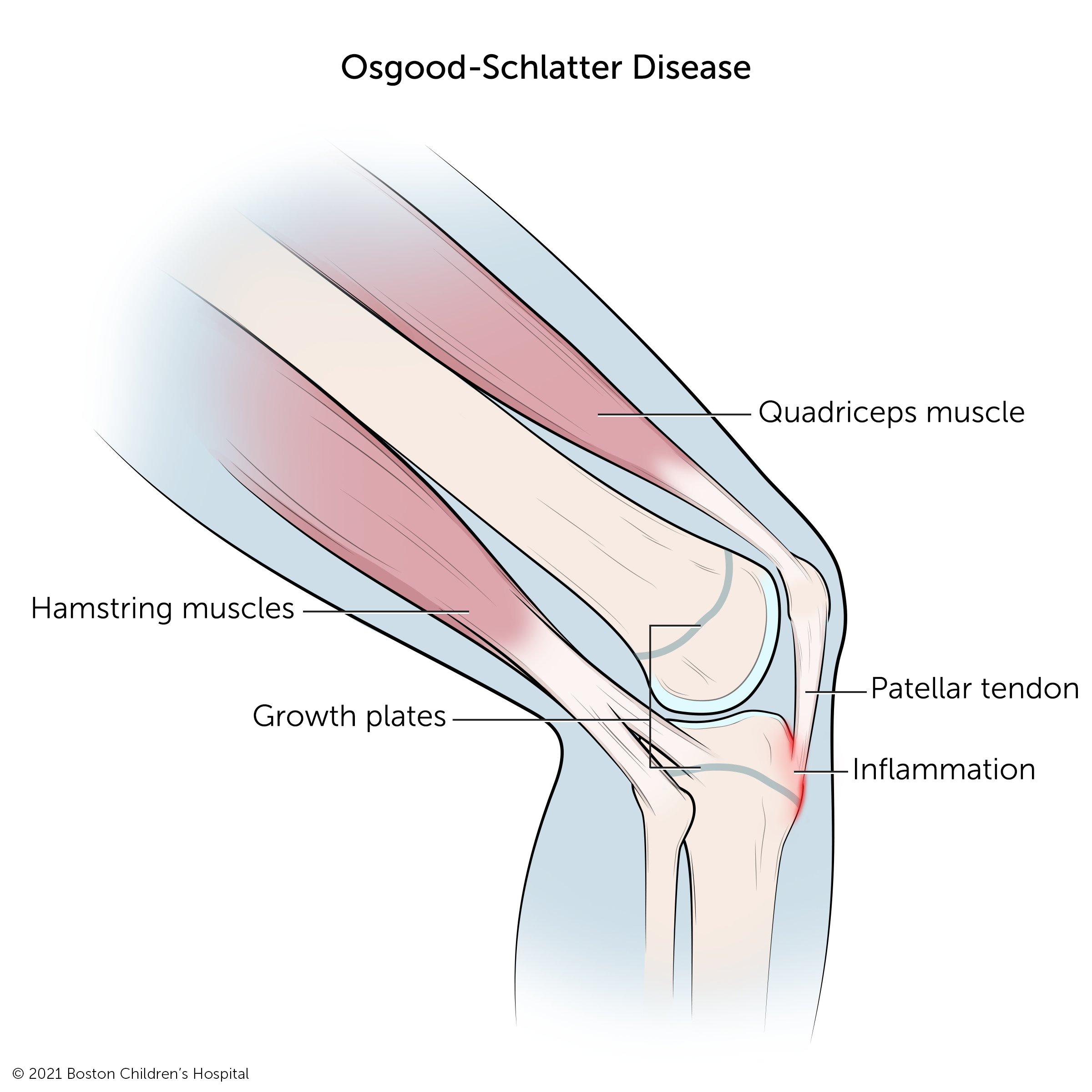What is Osgood-Schlatter disease?
Osgood-Schlatter disease is an overuse condition or injury of the knee that causes a painful bump and swelling on the shinbone below the knee.
Osgood-Schlatter disease typically affects kids during their preadolescent growth spurt: in the tweens (10 to 13) for girls and the early teens (12 to 14) for boys. At this stage, a child’s bones are typically growing faster than the muscles and tendons. As a result, the muscles and tendons have a tendency to become tight.
The condition is caused by the constant pulling of the patellar tendon on the area below the knee where the tendon attaches and is common in tween or teen athletes who play games or sports that involve running, jumping, or going up and down stairs. It is also common among athletes involved in football, soccer, basketball, gymnastics, or ballet.
Factors that increase the likelihood of Osgood-Schlatter disease include:
- tight quadriceps (front thigh) muscles
- tight hamstrings (back thigh) muscles

What are the symptoms of Osgood-Schlatter disease?
Each adolescent may experience symptoms of Osgood-Schlatter disease differently. They may include:
- tenderness below the knee
- swelling around the knee
- limping (may worsen following activities)
The symptoms of Osgood-Schlatter disease may resemble other conditions or medical problems of the knee. Therefore, it’s important to consult your child’s physician for a diagnosis.
How is Osgood-Schlatter disease diagnosed?
In addition to a complete medical history and physical examination, diagnostic procedures for Osgood-Schlatter disease may include:
- x-ray: a diagnostic test which uses invisible electromagnetic energy beams to produce images of internal tissues, bones, and organs onto film
- bone scan: a nuclear imaging method to evaluate any degenerative and/or arthritic changes in the joints; to detect bone diseases and tumors; to determine the cause of bone pain or inflammation
- magnetic resonance imaging (MRI): a diagnostic procedure that uses a combination of large magnets, radio frequencies, and a computer to produce detailed images of organs and structures within the body
- blood tests
How is Osgood-Schlatter disease treated?
Specific treatment for Osgood-Schlatter disease will be determined by your child’s physician based on:
- age, overall health, and medical history
- the extent of the condition
- tolerance for specific medications, procedures, or therapies
- expectations for the course of the condition
- your and your child’s opinions or preferences
The goal of treatment is to control the knee pain and limit your teen's activities that could aggravate the condition. Treatment may include:
- R.I.C.E.: rest, ice, compression, and elevation
- medications to ease physical discomfort
- elastic wrap or a neoprene knee sleeve around the knee
- activity restrictions
- physical therapy to help stretch and strengthen the thigh and leg muscles
What is the long-term outlook for tweens and teens with Osgood-Schlatter disesase?
Osgood-Schlatter disease often resolves with time. Kids rarely need surgery for this condition.
How we care for Osgood-Schlatter disease
Our team in the Sports Medicine Division includes sports medicine physicians, physical therapists, and athletic trainers who work with young athletes with a focus on recovery and safe return to play. We collaborate regularly with colleagues throughout the hospital and The Micheli Center for Sports Injury Prevention to provide an accurate diagnosis and prompt, effective treatment for each of our patients.
Osgood-Schlatter Disease | Programs & Services
Programs
Lower Extremity Program
Program
The Lower Extremity Program offers comprehensive diagnosis and treatment for children with lower extremity disorders.
Sports Ultrasound Clinic
Program
The Sports Ultrasound Clinic uses innovative technology to diagnose injuries of the joints, ligaments, and muscles.
Departments
Sports Medicine Division
Department
The Pediatric Sports Medicine Division provides comprehensive care to athletes of all ages and abilities, from professional athletes to eager novices.
Centers
Orthopedic Center
Center
Established in 1903, we are one of the world’s most experienced pediatric orthopedic centers. Learn more.


